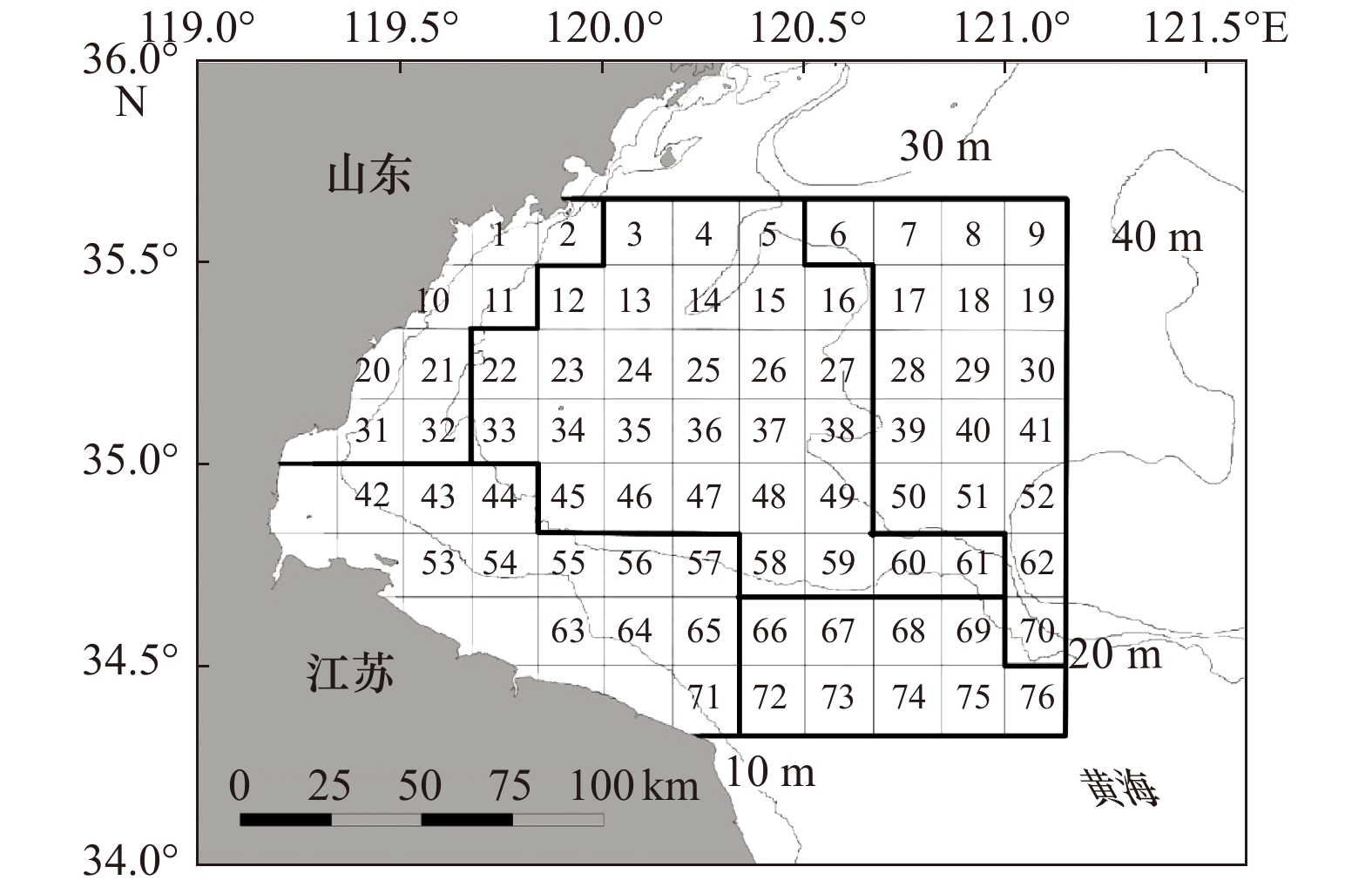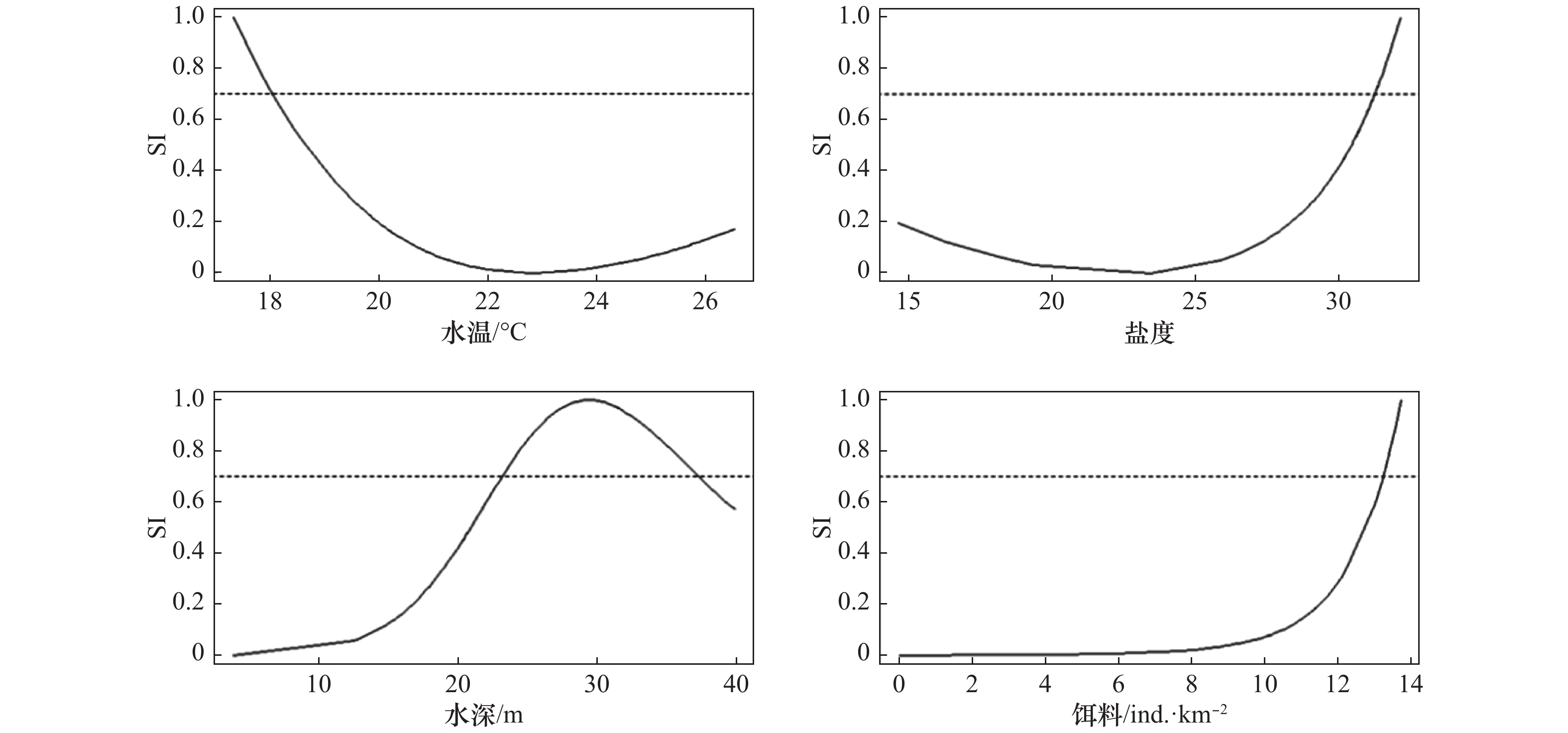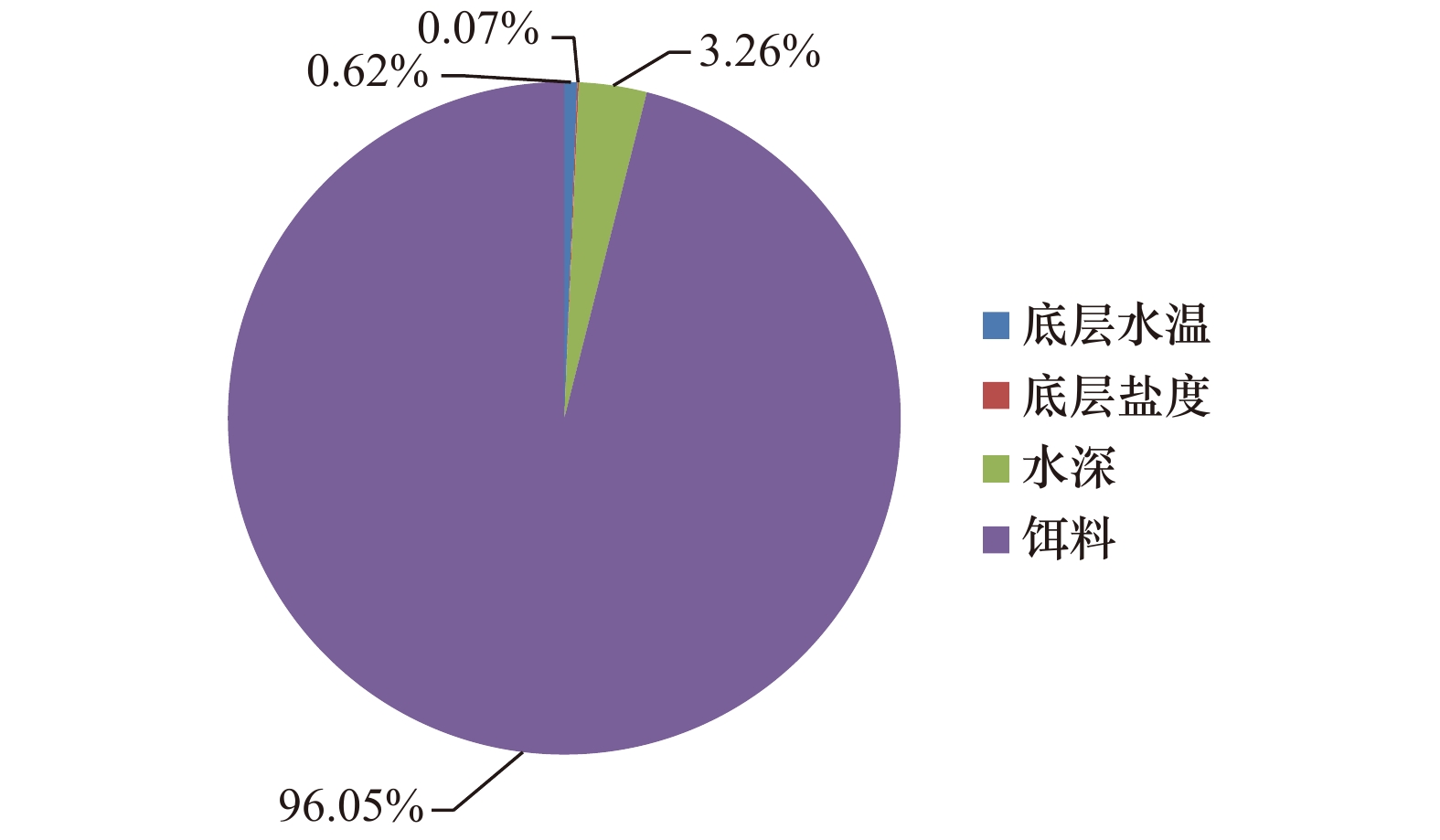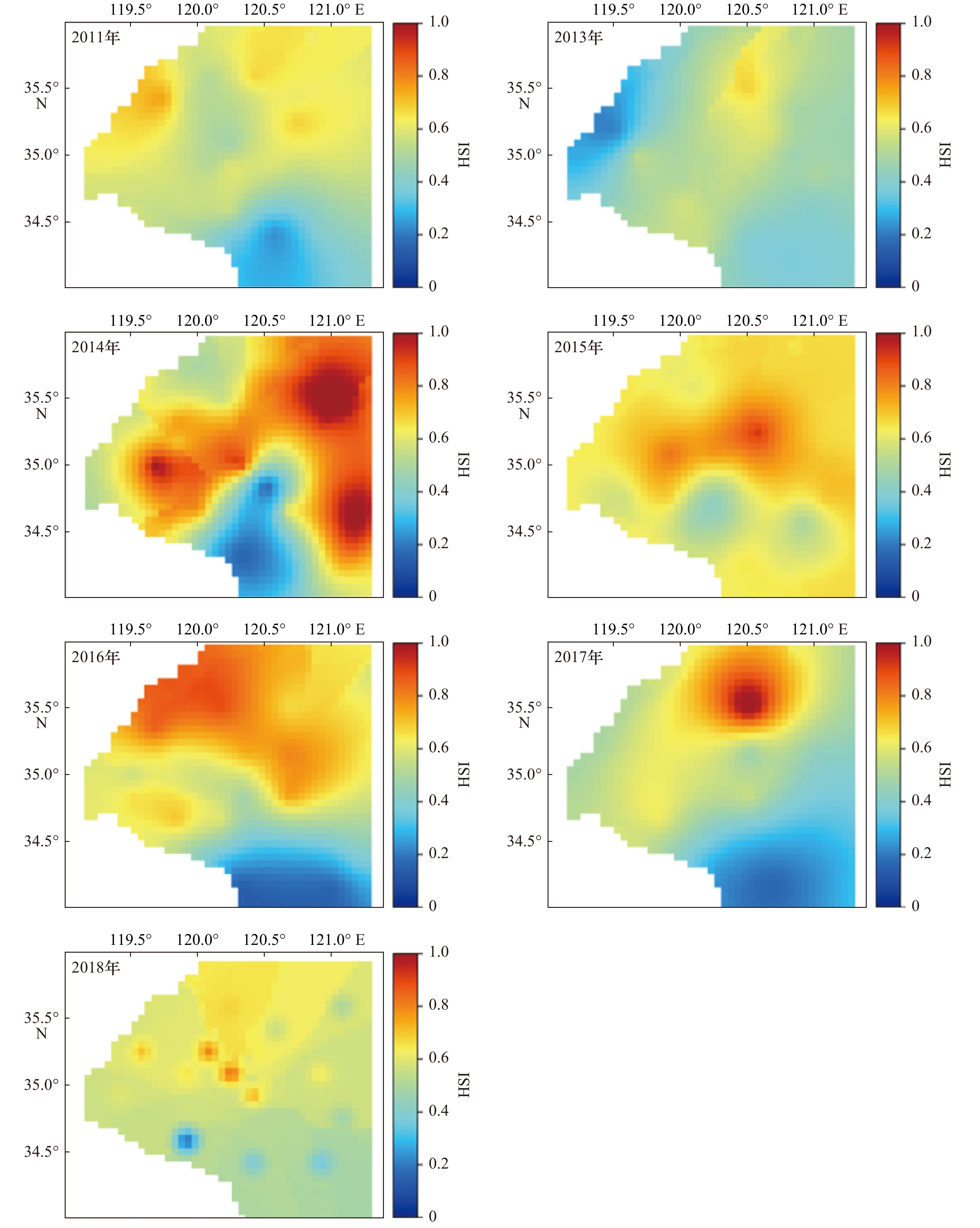Impacts of biotic and abiotic factors on the habitat suitability of Saurida elongata during autumn in the Haizhou Bay, China
-
摘要: 根据2011年和2013−2018年秋季在海州湾及邻近海域进行的底拖网调查数据,结合同步采集的底层水温、底层盐度、水深、资源密度、饵料生物等生物和非生物因子数据,开展长蛇鲻(Saurida elongata)栖息地适宜性的相关研究。利用提升回归树(Boosted Regression Tree, BRT)模型确定各环境因子的权重,分别采用算术平均法和几何平均法建立栖息地适宜性指数(Habitat Suitability Index, HSI)模型,并通过交叉验证确定最优模型。结果表明:海州湾长蛇鲻在秋季最适宜栖息的底层水温范围为17.5~18℃,最适底层盐度范围为31.3~32.0,最适水深范围为24~37 m;选择其3种主要饵料生物作为生物因子,即枪乌贼(Loligo spp.)、戴氏赤虾(Metapenaeopsis dalei)和六丝钝尾鰕虎鱼(Amblychaeturichthys hexanema),与底层水温、底层盐度和水深共同作为影响因子建立HSI模型。结果显示,对长蛇鲻空间分布总偏差贡献率最高的是饵料因子,其次是水深和底层水温。通过交叉验证发现,运用算术平均算法,且赋予权重的HSI模型具有较低的赤池信息准则值(Akaike Information Criterion, AIC)。研究发现,海州湾秋季长蛇鲻的最适栖息地(HSI≥0.7)主要分布在34.5°~36°N,119°~121°E之间,其中35°~36°N海域的最适栖息地分布范围大,而且从近岸至远海,HSI指数有增加的趋势。Abstract: According to the demersal trawling survey data in the Haizhou Bay and its adjacent waters in autumn of 2011 and 2013−2018, we studied the habitat suitability of Saurida elongata, using biotic and abiotic factors data, such as bottom water temperature, bottom salinity, water depth, resource density, bait biology, collected synchronously. The weight of each environmental factor was determined by using the model of boost regression tree (BRT), and the habitat suitability index (HSI) model was established by using arithmetic mean method and geometry mean method respectively, and the optimal model was determined by cross validation. The results show that the most suitable bottom water temperature range for the Saurida elongata to inhabit in fall was 17.5−18℃, the most suitable bottom salinity range was 31.3−32, and the most suitable water depth range was 24−37 m. Three main bait organisms were selected as biological factors, namely, Loligo spp., Metapenaeopsis dalei and Amblychaeturichthys hexanema. The HSI model was established with the bottom water temperature, bottom salinity and water depth as the influencing factors. The results show that the feed factors contributed most significantly to the total deviation of spatial distribution, followed by the water depth and bottom water temperature. Through cross validation, it is found that the weighted HSI model with arithmetic mean method algorithm has lower Akaike Information Criterion (AIC). The results show that the most suitable habitat (HSI≥0.7) of Saurida elongata in autumn was 34.5°−36°N, 119°−121°E, among which 35°−36°N was the most suitable habitat, and the HSI increased from near shore to sea.
-
表 1 基于AMM算法和GMM算法的海州湾长蛇鲻HSI模型的交叉验证
Tab. 1 Cross-validation of HSI model of the Haizhou Bay Saurida elongata based on AMM and GMM algorithm in mean confidence interval
因子组合 AMM GMM R2 AIC R2 AIC A 0.607 68 2.351 35 0.584 29 3.536 79 B 0.334 34 15.573 71 0.316 75 16.161 72 C 0.158 37 19.380 21 0.059 77 22.000 57 D 0.607 10 2.596 00 0.088 82 22.215 53 E 0.879 06 −24.771 30 0.751 92 −14.411 00 表 2 AMM模型和GMM模型预测性能的比较
Tab. 2 Comparison of prediction performance of AMM and GMM
AMM GMM R2 AIC R2 AIC 0.879 06 −24.771 3 0.751 92 −14.411 0.719 36 −43.510 4 0.180 54 −40.540 6 0.956 35 −5.062 3 0.951 2 15.563 29 -
[1] 王燕平. 长蛇鲻群体形态学与遗传学研究[D]. 青岛: 中国海洋大学, 2015.Wang Yanping. Study on morphology and genetics of Saurida elongta[D]. Qingdao: Ocean University of China, 2015. [2] 范润珍, 宋文东, 彭少伟. 长蛇鲻肌肉营养成分的分析[J]. 营养学报, 2005, 27(4): 349−350. doi: 10.3321/j.issn:0512-7955.2005.04.025Fan Runzhen, Song Wendong, Peng Shaowei. The nutritional components of the muscle of Saurida elongata[J]. Acta Nutrimenta Sinica, 2005, 27(4): 349−350. doi: 10.3321/j.issn:0512-7955.2005.04.025 [3] 陈素芝. 中国动物志: 硬骨鱼纲 灯笼鱼目 鲸口鱼目 骨舌鱼目[M]. 北京: 科学出版社, 2002.Chen Suzhi. Fauna Sinica: Osteophyta: Orthodontidae, Lantern Fish, Cetaceae, Hyoid[M] Beijing: Science Press, 2002. [4] 杨纪明. 渤海鱼类的食性和营养级研究[J]. 现代渔业信息, 2001, 16(10): 10−19.Yang Jiming. A study on food and trophic levels of Baohai Sea fish[J]. Modern Fisheries Information, 2001, 16(10): 10−19. [5] 龚彩霞, 陈新军, 高峰, 等. 栖息地适宜性指数在渔业科学中的应用进展[J]. 上海海洋大学学报, 2011, 20(2): 260−269.Gong Caixia, Chen Xinjun, Gao Feng, et al. Review on habitat suitability index in fishery science[J]. Journal of Shanghai Ocean University, 2011, 20(2): 260−269. [6] Ruger N, Schluter M, Matthies M. A fuzzy habitat suitability index for Populus euphratica in the Northern Amudarya delta (Uzbekistan)[J]. Ecological Modelling, 2005, 184(2/4): 313−328. [7] Brambilla M F, Casale V, Bergero G, et al. GIS-models work well, but are not enough: habitat preferences of Lanius collurio at multiple levels and conservation implications[J]. Biological Conservation, 2009, 142(10): 2033−2042. doi: 10.1016/j.biocon.2009.03.033 [8] Imam E, Kushwaha S P S, Singh A. Evaluation of suitable tiger habitat in Chandoli National Park, India, using spatial modelling of environmental variables[J]. Ecological Modelling, 2009, 220(24): 3621−3629. doi: 10.1016/j.ecolmodel.2009.06.044 [9] Hastie T, Tibshirani R, Friedman J. The Elements of Statistical Learning: Data Mining, Inference, and Prediction[M]. New York: Springer, 2001: 299−345. [10] Abeare S. Comparisons of boosted regression tree, GLM and GAM performance in the standardization of yellowfin tuna catch-rate data from the Gulf of Mexico longline fishery[D]. Baton Rouge: Louisiana State University, 2009: 1−94. [11] Elith J, Leathwick J R, Hastie T. A working guide to boosted regression trees[J]. Journal of Animal Ecology, 2008, 77(4): 802−813. doi: 10.1111/j.1365-2656.2008.01390.x [12] Froeschke B F, Tissot P, Stunz G W, et al. Spatiotemporal predictive models for juvenile southern flounder in Texas estuaries[J]. North American Journal of Fisheries Management, 2013, 33(4): 817−828. doi: 10.1080/02755947.2013.811129 [13] Lewin W C, Mehner T, Ritterbusch D, et al. The influence of anthropogenic shoreline changes on the littoral abundance of fish species in German lowland lakes varying in depth as determined by boosted regression trees[J]. Hydrobiologia, 2014, 724(1): 293−306. doi: 10.1007/s10750-013-1746-8 [14] Compton T J, Morrison M A, Leathwick J R, et al. Ontogenetic habitat associations of a demersal fish species, Pagrus auratus, identified using boosted regression trees[J]. Marine Ecology Progress Series, 2012, 462: 219−230. doi: 10.3354/meps09790 [15] Soykan C U, Eguchi T, Kohin S, et al. Prediction of fishing effort distributions using boosted regression trees[J]. Ecological Applications, 2014, 24(1): 71−83. doi: 10.1890/12-0826.1 [16] Jordaan A, Chen Yong, Townsend D W, et al. Identification of ecological structure and species relationships along an oceanographic gradient in the Gulf of Maine using multivariate analysis with bootstrapping[J]. Canadian Journal of Fisheries and Aquatic Sciences, 2010, 67(4): 701−719. doi: 10.1139/F10-010 [17] Xu Binduo, Zhang Chongliang, Xue Ying, et al. Optimization of sampling effort for a fishery-independent survey with multiple goals[J]. Environmental Monitoring and Assessment, 2015, 187(5): 252. doi: 10.1007/s10661-015-4483-9 [18] 中华人民共和国国家质量监督检验检疫总局, 中国国家标准化管理委员会. GB/T 12673−2007, 海洋调查规范[S]. 北京: 中国标准出版社, 2008.General Administration of Quality Supervision, Inspection and Quarantine of the People’s Republic of China, National Standardization Management Committee of China. GB/T 12673−2007, Specifications for oceanographic survey[S]. Beijing: China Standards Press, 2008. [19] 邓景耀,姜卫民,杨纪明,等. 渤海主要生物种间关系及食物网的研究[J]. 中国水产科学, 1997, 4(4): 1−7.Deng Jingyao, Jiang Weimin, Yang Jiming, et al. Species interaction and food web of major predatory species in the Bohai Sea[J]. Chinese Journal of Fisheries, 1997, 4(4): 1−7. [20] 刘西方. 海州湾两种高营养级鱼类摄食生态及其食物关系研究[D]. 青岛: 中国海洋大学, 2015.Liu Xifang. Study on feeding ecology and food relations of two high trophic level fishes in Haizhou Bay[D]. Qingdao: Ocean University of China, 2015. [21] 詹秉义. 渔业资源评估[M]. 北京: 中国农业出版社, 1995.Zhan Bingyi. Fishery Resources Assessment[M]. Beijing: China Agricultural Press, 1995. [22] Chang Y J, Sun C L, Chen Yong, et al. Habitat suitability analysis and identification of potential fishing grounds for swordfish, Xiphias gladius, in the South Atlantic Ocean[J]. International Journal of Remote Sensing, 2012, 33(23): 7523−7541. doi: 10.1080/01431161.2012.685980 [23] Xue Ying, Guan Lisha, Tanaka K, et al. Evaluating effects of rescaling and weighting data on habitat suitability modeling[J]. Fisheries Research, 2017, 188: 84−94. doi: 10.1016/j.fishres.2016.12.001 [24] Wakeley J S. A method to create simplified versions of existing Habitat Suitability Index (HSI) models[J]. Environmental Management, 1988, 12(1): 79−83. doi: 10.1007/BF01867379 [25] Vincenzi S, Caramori G, Rossi R, et al. A GIS-based habitat suitability model for commercial yield estimation of Tapes philippinarum in a Mediterranean coastal lagoon (Sacca di Goro, Italy)[J]. Ecological Modelling, 2006, 193(1/2): 90−104. [26] Tanaka K, Chen Yong. Spatiotemporal variability of suitable habitat for American lobster (Homarus americanus) in Long Island Sound[J]. Journal of Shellfish Research, 2015, 34(2): 531−543. doi: 10.2983/035.034.0238 [27] Chen Changsheng, Gao Guoping, Zhang Yu, et al. Circulation in the Arctic Ocean: results from a high-resolution coupled ice-sea nested Global-FVCOM and Arctic-FVCOM system[J]. Progress in Oceanography, 2016, 141: 60−80. doi: 10.1016/j.pocean.2015.12.002 [28] 都煜, 徐宾铎, 薛莹, 等. 海州湾及邻近海域日本枪乌贼时空分布的异质性[J]. 中国水产科学, 2017, 24(3): 558−565. doi: 10.3724/SP.J.1118.2017.16184Du Yu, Xu Binduo, Xue Ying, et al. Analysis of temporal and spatial heterogeneity of Japanese squid (Loliolus japonica) in Haizhou Bay and adjacent waters[J]. Journal of Fishery Sciences of China, 2017, 24(3): 558−565. doi: 10.3724/SP.J.1118.2017.16184 [29] 邹易阳, 薛莹, 麻秋云, 等. 应用栖息地适宜性指数研究海州湾小黄鱼的空间分布特征[J]. 中国海洋大学学报, 2016, 46(8): 54−63.Zou Yiyang, Xue Ying, Ma Qiuyun, et al. Spatial distribution of Larimichthys polyactis in Haizhou Bay based on habitat suitability index[J]. Periodical of Ocean University of China, 2016, 46(8): 54−63. [30] 陈新军. 渔业资源与渔场学[M]. 北京: 海洋出版社, 2004.Chen Xinjun. Fishery Resources and Fishing Ground[M]. Beijing: China Ocean Press, 2004. [31] 王家樵, 朱国平, 许柳雄. 基于HSI模型的印度洋大眼金枪鱼栖息地研究[J]. 海洋环境科学, 2009, 28(6): 739−742. doi: 10.3969/j.issn.1007-6336.2009.06.034Wang Jiaqiao, Zhu Guoping, Xu Liuxiong. Using HSI model for analyzing the habitat suitability of bigeye tuna (Thunnus obesus) in the Indian Ocean[J]. Marine Environmental Science, 2009, 28(6): 739−742. doi: 10.3969/j.issn.1007-6336.2009.06.034 [32] 冯波, 田思泉, 陈新军. 基于分位数回归的西南太平洋阿根廷滑柔鱼栖息地模型研究[J]. 海洋湖沼通报, 2010(1): 15−22. doi: 10.3969/j.issn.1003-6482.2010.01.003Feng Bo, Tian Siquan, Chen Xinjun. The habitat suitability index of Illex argentinus by using quantile regression method in the southwest Atlantic[J]. Transactions of Oceanology and Limnology, 2010(1): 15−22. doi: 10.3969/j.issn.1003-6482.2010.01.003 [33] 宋利明, 高攀峰, 周应祺, 等. 基于分位数回归的大西洋中部公海大眼金枪鱼栖息环境综合指数[J]. 水产学报, 2007, 31(6): 798−804.Song Liming, Gao Panfeng, Zhou Yingqi, et al. Habitat environment integration index of Thunnus obesus in the high seas of the Central Atlantic Ocean based on the quantile regression[J]. Journal of Fisheries of China, 2007, 31(6): 798−804. -





 下载:
下载:



